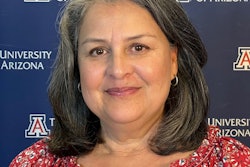 During the many FAFSA drives, current and potential students at UTPA were equipped with computers and professional guidance to complete the FAFSA. (Photo courtesy of the University of Texas-Pan American)
During the many FAFSA drives, current and potential students at UTPA were equipped with computers and professional guidance to complete the FAFSA. (Photo courtesy of the University of Texas-Pan American)When the Texas Higher Education Coordinating Board discovered through a study in 2000 that the state would lose tax revenue and see a drop in income because its colleges and universities weren’t keeping pace with population growth, it took action with the Closing the Gaps plan. The plan has a particular aim at educating more Hispanic students.
“I think we’ve made very substantial progress,” says Dr. Raymund Paredes, commissioner of the Texas Higher Education Coordinating Board (THECB). “I’m not suggesting we are where we’re going to be, but we’ve done some pretty extraordinary things.”
As of 2013, the last year for available data, the 15-year plan, which ends next year, has more than doubled the number of Hispanics enrolled in college in the state from around 240,000 to 526,310. “I think having a plan with specific goals was helpful,” says Paredes, reflecting on the initiative’s trajectory. “We had targets for specific institutions, and I think that helped.”
According to Paredes, all of the state’s Hispanic-serving institutions, such as the University of Texas at El Paso and the University of Texas Pan-American (UTPA), have performed well at increasing Hispanic enrollment and improving retention. “We had a concerted effort, and we’re seeing results,” says Paredes.
Implementing plans
This aligned effort moved forward by basing projects on data.
“We used workforce data to project what [was] needed,” says Susan Brown, assistant commissioner of the THECB. “We work[ed] very closely with the state demographer’s office.”
Jumping off from that, THECB let each school know what needed to be accomplished and individual campuses crafted their plans from there. As Brown says, referring to the individual campus plans, “one size does not fit all.”
In efforts to increase enrollment, several community colleges began offering baccalaureate degrees and institutions started to build a pipeline with K-12 students. A majority of low-income Hispanic students start out at two-year schools, Paredes notes, according to the Coordinating Board’s Tuning Texas plan, which helped associate degree students transfer to four-year schools.
“Texas has been very aggressive about making sure that anybody that wants a college credential can get one. We have three community colleges in Texas that offer bachelor’s degrees. The whole intention of that was to make sure that we had low-cost pathways for students to attain bachelor’s degrees,” Paredes says.
However, he says, “we realized we couldn’t achieve our goals if K-12 wasn’t doing its job. We have worked all the critical points of the pipeline.”
UTPA, for example, started a program to help area high school students apply for college. “We help them to apply to any college because obviously our goal is for the students in the Rio Grande Valley to attend college,” says Dr. Magdalena Hinojosa, senior associate vice president for enrollment services at UTPA. For Hispanic student enrollment, she notes, “Our goal is to be at 20,826. I am very happy to report that we are at fall 2014 and we’re going to hit 21,000.”
Other initiatives the campus has undertaken include mentoring programs, a frameworks course to identify students that need additional assistance, and a centralized advising system for freshmen and sophomores. The Freshman Faculty Mentoring Program, Bronc Mentoring Experience, and Learning Framework course ease the transition from high school to college and then from first to second to third years of university.
“When you have a specific program that goes for a certain goal you are just pushed a bit more,” says Hinojosa. “When [we] actually have to put some numbers in black and white, and we’re going to be held responsible, then we are going to do everything to meet that goal.”
A particular software has also helped administrators gauge what courses need to be scheduled for each semester, according to the need among students. “It’s important for student success to offer the classes they need when they need them,” says Hinojosa. Her university also put into place admission standards.
Rebecca Treviño, manager of the University of Houston’s Academic Achievers program, says it’s about helping students graduate at a faster rate. The Academic Achievers program pulls in first-generation college students from a Hispanic background and makes sure they complete their studies in a timelier manner. “Closing the Gaps is making education available to underrepresented students in the state,” she notes.
Issues and looking forward
So far the greatest issues Paredes says he has seen among Hispanic students is that they have come to college unprepared for the coursework and may face financial aid challenges. Addressing the latter need, Hinojosa says UTPA hosts FAFSA workshops in the spring to get students on the right track.
While other states have similar issues, what has given Texas a leg up is its wealth of information on its students. “The only state that has a database that is as rich as ours is Florida,” he notes. “We could do analysis on the spot.”
For example, Paredes says they have found that Hispanic students often drop out in the eighth or 10th grades. The board’s information gathering has also revealed that many don’t make it to college after having been accepted.
“We know a lot of Hispanics drop out of school because they have to support their families, and we try to make sure they come back,” he says. Adding to tapping into a wealth of information, having the same governor throughout the plan has worked to its advantage. “When governors change, typically priorities change,” he says.
So how will things change now that the plan is coming to an end?
“We’re not going to stop wanting to excel in what we are designed to do,” says Hinojosa, “which is to graduate students.”
In fact, a follow-up plan is in the works, set to launch immediately after Closing the Gaps’ completion in 2016. A committee has already started meeting once a month to create it, notes Brown. “There will be another 15-year plan,” she says.
While Paredes says he doubts that any other state with the same size Hispanic population has been able to do what Texas has done, he does point out that there is room for improvement in the next plan.
“We haven’t had as many graduates in the STEM fields as we would have liked. We haven’t produced as many bilingual teachers as we had hoped, [too],” he says.
Overall, though, he says he is pleased that the state is doing a better job of graduating Hispanics in college than enrolling them.
“We’re just creating as many different pathways as we can for the great diversity of students we have in this state.”















